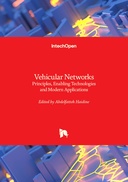Explore

Vehicles have played a major role in the development of societies over generations. Their role will reach the next level of importance and innovation with the development of intelligent/smart or connected vehicles, which will take over some (assisted driving) or all (fully autonomous driving) of the driver’s responsibility in operating the vehicle. However, this (re)evolution cannot be achieved without a robust, secure, and highly reliable communications infrastructure. Indeed, vehicular communication technologies offer a wide range of benefits that address key challenges in transportation, including safety, efficiency, sustainability, and user experience. As these technologies continue to evolve and mature, they have the potential to transform the way people and goods move, shaping the future of mobility for generations to come. This book deals with modern aspects related to vehicular communications. The first section discusses modern applications for new vehicle applications, such as automated guided vehicles in smart maritime ports, logistics assets, and so on. The second section of the book explores the advantages of some modern approaches to optimizing the functioning of vehicular communications, such as machine learning as a part of artificial intelligence, and the different security concerns of connected vehicles and infrastructures.
This book is included in DOAB.
Why read this book? Have your say.
You must be logged in to comment.
Rights Information
Are you the author or publisher of this work? If so, you can claim it as yours by registering as an Unglue.it rights holder.Downloads
This work has been downloaded 56 times via unglue.it ebook links.
- 31 - pdf (CC BY) at Unglue.it.
- 25 - pdf (CC BY) at mts.intechopen.com.
Keywords
- Automotive technology and trades
Links
DOI: 10.5772/intechopen.102303Editions

